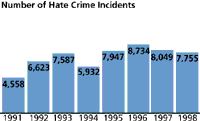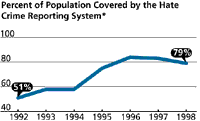
Hate Crimes: Better Data or Increasing Frequency?
(July 2000) Outlawing hatred may not be possible, but members of Congress have introduced legislation regarding hate-motivated violence, in response to what some activists call a hate crime “epidemic.” The latest outbreak — the fatal shootings of a Jewish woman, an Indian man, and two Asian men in a Pittsburgh suburb in late April — has intensified the demand for a policy response.

Source: Federal Bureau of Investigation, 1999.
Hate crime, like domestic violence, sexual harassment, stalking, and date rape, is a relative newcomer to the American lexicon of criminal law and public policy, although intergroup conflict and violence are enduring characteristics of human societies everywhere. Representative John Conyers, Jr., a Democrat from Michigan, coined the term “hate crime” in 1985 to refer to acts of racial, religious, and anti-immigrant violence. Since 1985, the definition has come to include acts of violence based on sexual orientation, gender, and disability. Although the kinds of conduct and the groups that should be covered under the law are fairly clear, many of the details about applying the law remain sketchy.
Ambiguity about the meaning of hate crimes has made it difficult to collect reliable data about the phenomena. American crime statistics come from the Uniform Crime Reporting (UCR) program of the Federal Bureau of Investigation, which compiles statistical reports from state and local law enforcement agencies. Requests for hate crime data began in 1990, a time when many states still had not passed a hate crime statute. Participation in the UCR program has increased in the last decade, but state involvement remains highly variable (see figure below).

* Population covered by the law enforcement agencies participating in the system.
Source: Federal Bureau of Investigation, 1999.
For example, in 1998, several states had fewer than 10 law enforcement agencies submitting hate crime reports to the FBI. Southern and Midwestern states that never passed hate crime statutes or passed them only recently reported the fewest incidents. On the other side of the spectrum, California, a leader in hate crime policymaking, has accounted for nearly a quarter of all of the reported incidents of hate crime since the system was implemented. The impression left, which is probably mistaken, is that more hate-motivated criminal behavior takes place where hate crime reporting is most robust. Even within states, social science research shows considerable variation in how local law enforcement agencies classify and count hate crime. Basic questions, such as “Are hate crimes increasing?” and “What are the typical scenarios that lead to violence?” remain largely unanswerable.
Hate Crimes Prevention Act of 1999
This act would establish federal jurisdiction over certain violent crimes motivated by bias, enabling federal, state, and local authorities to work together to investigate and prosecute such crimes. The act would also provide federal assistance to states and local jurisdictions for training local law enforcement officers in investigating, prosecuting, and preventing hate crimes.
On June 20, the Senate voted 57 to 42 in favor of this initiative, which was approved as part of the defense authorization bill. Although action in the House is thought to be imminent, the outcome there is uncertain, and the 100-odd amendments to the Senate bill still pending cloud the legislation’s prospects in that body as well. The Supreme Court ruled in May that the Violence Against Women Act does not allow victims of gender-motivated violence to bring cases against their attackers in federal court — in other words, that these crimes fall within state jurisdiction.
Recent state and federal initiatives to standardize training programs for police will likely improve this situation. According to the federal Bureau of Justice Statistics, a majority of local agencies in California have implemented general policy orders regarding hate crime that establish internal departmental routines for handling cases. This will likely lead to a heightened understanding among frontline law enforcement officers of the definition of hate crime, typical sources of evidence, and protocols for dealing with them. Data collection will become more standardized as a result.
At this point, some of the best information comes from local rather than national sources. Relying on these local sources, social science researchers have begun to uncover some striking patterns. Research in Baltimore and New York City shows that most hate crime perpetrators are not members of organized hate groups. Instead, according to studies by James Garofalo and Susan Martin, hate crime perpetrators tend to be young men acting in informal groups. Findings thus far also point to a spatial and demographic basis for hate crime. A 1998 study by Donald Green, Dara Strolovitch, and Janelle Wong found evidence that predominantly white neighborhoods in New York City experiencing in-migration of minorities had higher rates of hate crime than areas with little or no in-migration of minorities. Work in Los Angeles County by Karen Umemoto and C. Kimi Mikami has produced strong evidence of race-based hate crime among street gangs of racial minorities who select victims not based on their membership in rival gangs but on their racial differences. Both studies point to the importance of territorial defense as a key underlying factor in the commission of hate crime.
While such findings are provoking, a broader understanding of hate crime must wait until the quality and reliability of data improve.
Ryken Grattet is an assistant professor of sociology at the University of California, Davis, and author, with Valerie Jenness, of Building the Hate Crime Policy Domain: From Social Movement Concept to Law Enforcement Practice, The American Sociological Association’s Rose Monograph Series (New York: Russell Sage Foundation, forthcoming).
For More Information
Hate Crimes
Elizabeth Boyd, Richard Berk, and Karl Hamner, “Motivated by Hatred or Prejudice: Categorization of Hate-Motivated Crimes in Two Police Divisions,” Law & Society Review 30 (1996): 819-850.
Donald Green, Dara Z. Strolovitch, and Janelle S. Wong, “Defended Neighborhoods, Integration, and Racially Motivated Crime,” American Journal of Sociology 104, no. 2 (1998): 372-403.
James Garofalo, “Hate Crime Victimization in the United States,” in Victims of Crime, eds. Wesley Skogan, Robert Davis, and Arthur Lurigio, 2d ed. (Thousand Oaks, Calif.: Sage Publications, 1997).
James Jacobs and Kimberly Potter, Hate Crimes: Criminal Law & Identity Politics (New York: Oxford University Press, 1998).
Susan Martin, “Investigating Hate Crimes: Case Characteristics and Law Enforcement Responses,” Justice Quarterly 13, no. 3 (1996): 455-480.
Karen Umemoto and C. Kimi Mikami, “A Profile of Race-Bias Hate Crime in Los Angeles County,” Western Criminological Review 2, no. 2 (2000), http://wcr.sonoma.edu/ (19 June 2000).






